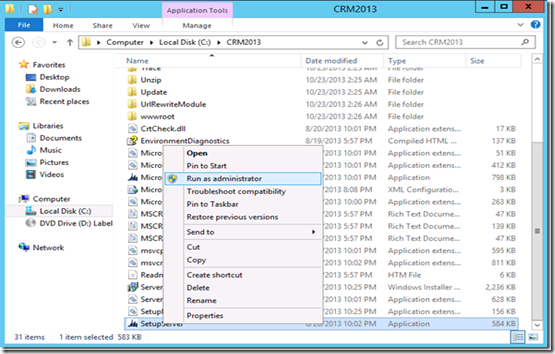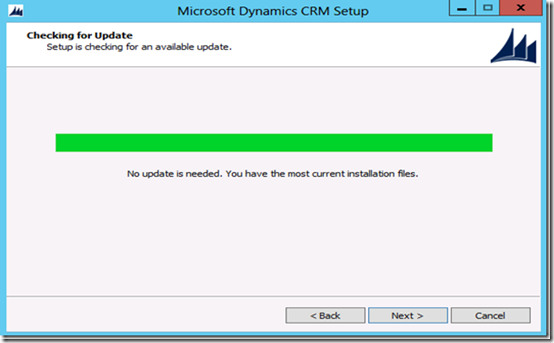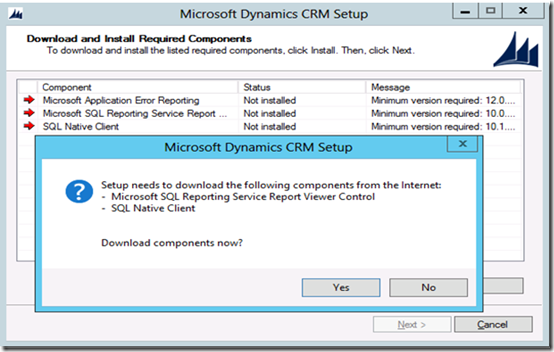Step by Step: Installing Dynamics CRM 2013 on Windows Server 2012
This blog covers the procedure to install Microsoft Dynamics CRM Server 2013 on a computer that does not already have Microsoft Dynamics CRM installed.
Before we proceed it is important we understand the minimum hardware and the software requirements for Installing CRM Server 2013.
Microsoft Dynamics CRM Server 2013 hardware requirements
The following table lists the minimum and recommended hardware requirements for Microsoft Dynamics CRM Server 2013 running in a Full Server configuration. These requirements assume that additional components such as Microsoft SQL Server, Microsoft SQL Server Reporting Services, SharePoint, or Microsoft Exchange Server aren't installed or running on the system.
Component |
*Minimum |
*Recommended |
Processor |
x64 architecture or compatible dual-core 1.5 GHz processor |
Quad-core x64 architecture 2 GHz CPU or higher such as AMD Opteron or Intel Xeon systems |
Memory |
2-GB RAM |
8-GB RAM or more |
Hard disk |
10 GB of available hard disk space Note Computers with more than 16GB of RAM will require more disk space for paging, hibernation, and dump files. |
40 GB or more of available hard disk space Note Computers with more than 16GB of RAM will require more disk space for paging, hibernation, and dump files. |
Microsoft Dynamics CRM Server 2013 software requirements
Windows Server operating system
Microsoft Dynamics CRM Server 2013 can be installed only on Windows Server 2008 or Windows Server 2012 64-bit-based computers.
Supported Windows Server 2012 editions
The following editions of the Windows Server 2012 operating system are supported for installing and running Microsoft Dynamics CRM Server 2013:
· Windows Server 2012 Datacenter
· Windows Server 2012 Standard
Supported Windows Server 2008 editions
The following editions of the Windows Server 2008 operating system are supported for installing and running Microsoft Dynamics CRM Server 2013:
· Windows Server 2008 Standard SP2 (x64 versions) or Windows Server 2008 Standard R2 SP1
· Windows Server 2008 Enterprise SP2 (x64 versions) or Windows Server 2008 Enterprise R2 SP1
· Windows Server 2008 Datacenter SP2 (x64 versions) or Windows Server 2008 Datacenter R2 SP1
· Windows Web Server 2008 SP2 (x64 versions) or Windows Web Server 2008 R2 SP1
Important
· Windows Server 2008 installed by using the Server Core installation option is not supported for installing and running Microsoft Dynamics CRM 2013 Server.
· Windows Server 2008 for Itanium-based systems isn't supported for installing and running Microsoft Dynamics CRM Server 2013.
Important
· The Windows Server 2003 family of operating systems aren't supported for installing and running Microsoft Dynamics CRM Server 2013.
· Microsoft Windows Small Business Server editions aren't supported for installing and running Microsoft Dynamics CRM Server 2013.
Active Directory modes
The computer that Microsoft Dynamics CRM Server 2013 is running on must be a member in a domain that is running in one of the following Active Directory service forest and domain functional levels:
· Windows Server 2003 Interim
· Windows Server 2003 Native
· Windows Server 2008 Interim
· Windows Server 2008 Native
· Windows Server 2012
Internet Information Services (IIS)
Microsoft Dynamics CRM Server 2013 supports Internet Information Services (IIS) versions 7, 7.5, and 8.0.
SQL Server editions
Any one of the following Microsoft SQL Server editions is required and must be installed on Windows Server 2008 (x64 SP2 or R2) versions or Windows Server 2012 64-bit-based computers, running, and available for Microsoft Dynamics CRM:
· Microsoft SQL Server 2008, Standard Edition, x64 SP3 or R2 SP2
· Microsoft SQL Server 2008, Enterprise Edition, x64 SP3 or R2 SP2
· Microsoft SQL Server 2008 Datacenter x64 SP3 or R2 SP2
· Microsoft SQL Server 2008 Developer x64 SP3 or R2 SP2 (for non-production environments only)
· Microsoft SQL Server 2012, Enterprise, 64-bit SP1
· Microsoft SQL Server 2012, Business Intelligence, 64-bit SP1
· Microsoft SQL Server 2012, Standard, 64-bit SP1
SQL Server Reporting Services
Specific Microsoft SQL Server Reporting Services editions are used for reporting functionality.
Any one of the following Microsoft SQL Server editions is required and must be installed on Windows Server 2008 (x64 SP2 or R2) versions or Windows Server 2012 64-bit-based computers, running and available for Microsoft Dynamics CRM:
· Microsoft SQL Server 2008, Standard Edition, x64 SP3 or R2 SP2
· Microsoft SQL Server 2008, Enterprise Edition, x64 SP3 or R2 SP2
· Microsoft SQL Server 2008 Datacenter x64 SP3 or R2 SP2
· Microsoft SQL Server 2008 Developer x64 SP3 or R2 SP2 (for non-production environments only)
· Microsoft SQL Server 2012, Enterprise, 64-bit SP1
· Microsoft SQL Server 2012, Business Intelligence, 64-bit SP1
· Microsoft SQL Server 2012, Standard, 64-bit SP1
Software component prerequisites
The following components must be installed and running on the computer where Microsoft Dynamics CRM 2013 Server will be installed:
· Services
· Indexing Service (Windows Server 2008)\ Windows Search (Windows Server 2012)
· IIS Admin
· World Wide Web Publishing
· Windows Data Access Components (MDAC) 6.0 (This is the default version of MDAC with Windows Server 2008.)
· Microsoft ASP.NET (Must be registered, but does not have to be running.)
Note: If not installed, they are installed for a Full Server during Microsoft Dynamics CRM Server Setup.
The Windows Search Service can be installed by navigating to Add Roles and Features Wizard and select Windows Search Service and click Next.
Continue the wizard to successfully complete the installation:
IIS(Internet Information Services) can be installed by navigating to Add Roles and Features Wizard and select Web Server (IIS) and click Next.
Continue the wizard to successfully complete the installation:
Note: To know more about the software and the hardware requirements you can download the CRM 2013 Implementation guide and go through the Planning guide
Dynamics CRM 2013 Installation D
1. Download the Dynamics CRM 2013 Server setup files from here
2. Run Microsoft Dynamics CRM Server Setup by navigating to the directory. It is recommended to do it with 'Run as Administrator'
3. Welcome to Microsoft Dynamics CRM Server 2013 Setup page
On this page, we recommend that you click Get updates for Microsoft Dynamics CRM, to make sure that Setup has the most recent installation files. Click Next.
4. If there is no update needed you can proceed with the setup by clicking Next.
5. Product Key Information
The next step is to enter the product key. You may insert a valid commercial product key or use one of the following 90-day trial keys.
Microsoft Dynamics CRM Workgroup Server 2013 (5 CAL limit):
NX77Y-BTBCV-JP3T3-8W7JH-94QJP
Microsoft Dynamics CRM Server 2013 (no CAL limit):
CQWW3-TNXBF-HRQWC-CVTW9-M968H
6. License Agreement page
On the License Agreement page, review the information and, if you accept the license agreement, click I accept this license agreement, and then click I Accept.
7. Install Required Components
If Setup detects that components are missing, the Install Required Components page appears.
· If you have already installed the required components, this page will not appear.
· If you have not installed the required components listed, you can install them now. Click Install. When the components are installed, the status column will change from Not Installed to Installed, and you can click Next to continue.
Note: If you are prompted to restart the computer, do so, and then start Setup again.
Once successfully installing all the required components, press Next to continue with the setup
8. Select Installation Location
On the Select Installation Location page, accept the default location or enter a different file installation location, and then click Next.
9. Specify Server roles
Here you can specify the server roles to install in the current server
To take advantage of additional performance and scaling benefits in enterprise deployments, consider distributing specific server functionality, components and services or server roles on different servers. Microsoft Dynamics CRM 2013 supports distribution and scaling of server roles across multiple servers.
There are 2 new services as part of the Back End Server roles and the Deployment Administration Server roles. These are the Email integration Service and the VSS writer service.
Email Integration Service |
Handles sending and receiving of email messages by connecting to an external email server |
VSS Writer Service |
This service provides an interface to backup and restore Dynamics CRM data by using the Windows Server Volume Shadow Copy service (VSS) infrastructure |
I will choose all the roles to be installed on the same server
10. Specify Deployment Options
On the Specify Deployment Options page, select the name of the computer that is running SQL Server to use the deployment box, type or select the instance of Microsoft SQL Server that will be used to store the Dynamics CRM database (MSCRM_CONFIG)
For a new installation of Dynamics CRM, we select the option Create a new deployment
11. Select the Organizational Unit
On the Select the Organizational Unit page, click Browse to display your Active Directory structure. Select the location where you want the Microsoft Dynamics CRM organizational unit to be installed into, click OK, and then click Next. Microsoft Dynamics CRM security groups are created in this organizational unit.
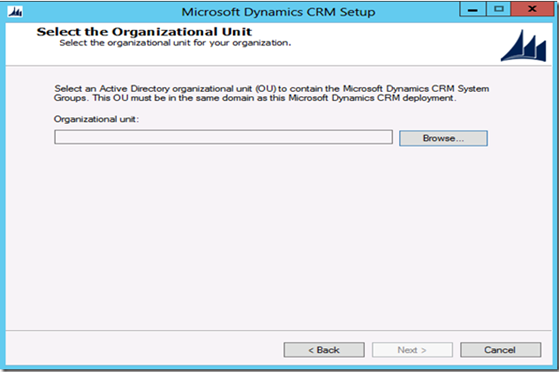

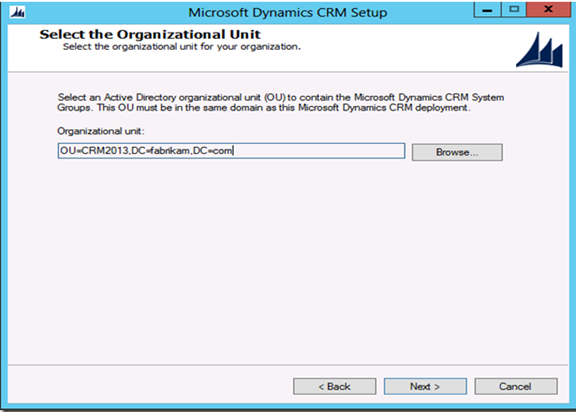
12. Specify Service Accounts
On the Specify Service Accounts page, select the security accounts for the Microsoft Dynamics CRM services, and then click Next.
For each service, we strongly recommend that you select a low-privilege domain account that is dedicated to running these services and is not used for any other purpose.
Additionally, the user account that is used to run a Microsoft Dynamics CRM service cannot be a Microsoft Dynamics CRM user. This domain account must be a member of the Domain Users group.
Additionally, if the Asynchronous Service and Sandbox Processing Service roles are installed, such as in a Full Server or a Back End Server installation, the domain account must a member of the Performance Log Users security group.
If you select to run the ASP.NET service under a domain user account that is not a domain administrator or a local administrator, you must set a local security policy after you install Microsoft Dynamics CRM Server 2013 for the ASP.NET service to work correctly. Also, depending on the password policies that you have implemented for your organization, the password for the user may expire
There are a couple of new services in CRM 2013
Monitoring Service |
Monitors all Microsoft Dynamics CRM 2013 server roles that are installed on the local computer. This service is used to detect expired digital certificates that may affect Microsoft Dynamics CRM 2013 services that are running in the deployment. |
VSS Writer service |
The Microsoft Dynamics CRM VSS Writer service provides an interface to backup and restore Dynamics CRM data by using the Windows Server Volume Shadow Copy Service (VSS) infrastructure. |

13. Select a Web Site
On the Select a Web Site page, click Create a new Web site or click Select a Web Site and select a website from the list. By default, Setup will use the default website.
Important: We strongly recommend that you verify the status of the existing website before you specify Setup to use an existing website. We strongly recommend that the website you select is configured for SSL. For more information see the IIS documentation. During the installation, Setup can bind the Microsoft Dynamics CRM application to the HTTPS website. If you select a network port other than a default port, ensure that the firewall does not block the port.
When you select the Create a new Web site option, Setup creates a new website for Microsoft Dynamics CRM. You can specify the following option:
Port Number: Type the TCP port number that Microsoft Dynamics CRM clients will use to connect to the Microsoft Dynamics CRM Server 2013. The default port number is 5555. Click Next
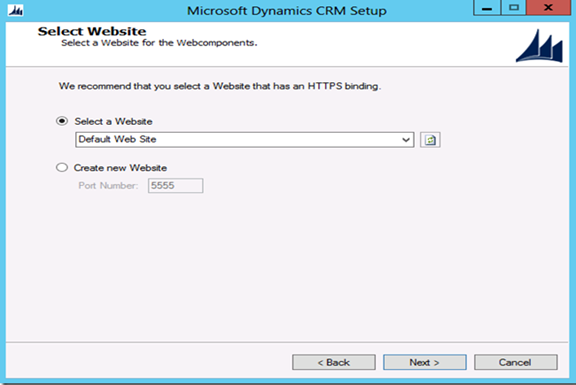
14. Specify E-mail Router Settings
On the Specify E-mail Router Settings page, in the E-mail Router server name box, type the name of the computer where the Email Router will be installed.
This computer will route Microsoft Dynamics CRM email messages. If you will not install the Email Router you can leave this box blank. However, if you install the Email Router later you must add the computer where the Email Router service is running when you use Local System, or if you use a domain user account, the account, to the PrivUserGroup security group. Click Next
Note: If you want to use Server Side Synchronization or do not want to specify the email router name you can leave it blank and click Next
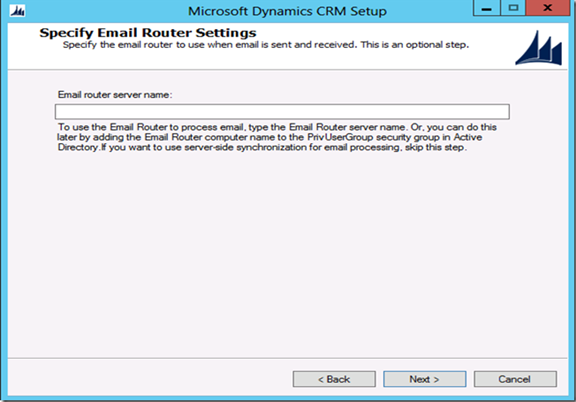
15. Specify the Organization Settings
On the Specify the Organization Name page, specify the following information.
- In the Display Name box, type the name of your organization.
- In the Unique Database Name box, you can keep the name that is automatically generated or you can type a unique name that must be limited to 30 characters. Spaces and extended characters are not allowed.
- Under ISO currency code, click Browse, select the ISO currency code that you will use as the base currency for the organization in the list, and then click OK.
You can change the currency's symbol, name, or precision. - In the SQL collation list, keep the default selection or select a different database collation that the organization database will use to sort and compare data characters.
Click Next.
Important
After Setup is complete, you cannot change the database collation, base ISO currency code, or the organization unique name. However, you can change the base currency name and base currency symbol.

16. Specify Reporting Services Server
On the Specify Reporting Services Server page, type the Report Server URL. Make sure that you use the Report Server URL, not the Report Manager URL.
To verify that you are using the correct URL, in a browser, type the Report Server URL as the address.
Click Next

17. Help us Improve the Customer Experience
On the Help Us Improve the Customer Experience page, select whether you want to participate in the Customer Experience Improvement Program, and then click Next

18. Select Microsoft Update Option page
On the Select Microsoft Update Option page, you must select either of the following options.
Use Microsoft Update when I check for updates (recommended) - By selecting this option, Microsoft Dynamics CRM Server will use the Microsoft Update settings on the computer.
I don't want to use Microsoft update- You should only select this option if the computer uses another method to install updates such as by using Microsoft Windows Server Update Services (WSUS).
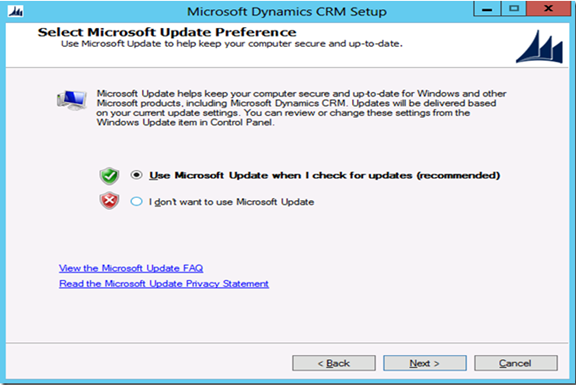
19. System Checks
This page is a summary of all requirements and recommendations for a successful installation. Errors must be resolved before installation can continue. If no errors, or only warnings appear, you can continue with the installation. To do this, click Next

20. Service Disruption Warning
This page lists all services that will be stopped or restarted during Setup.
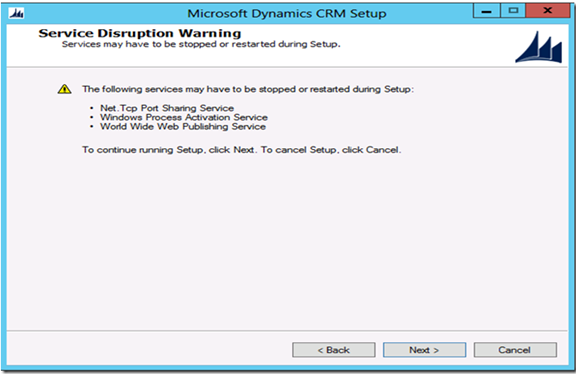
21. Ready to Install Microsoft Dynamics CRM
Review the Ready to Install Microsoft Dynamics CRM page, and then click Back to correct any warnings. When you are ready to continue, click Install.

Once the installation is successful you can launch the Reporting Extensions setup
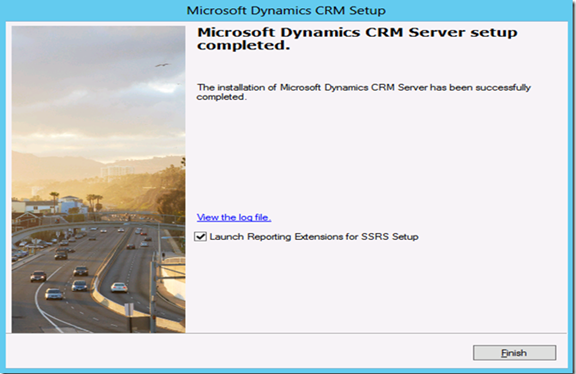
Install Microsoft Dynamics CRM 2013 Reporting Extensions
You must complete Microsoft Dynamics CRM Server Setup before you run CRM Reporting Extensions Setup.
You must run Microsoft Dynamics CRM Reporting Extensions Setup on a computer that has a supported version of Microsoft SQL Server Reporting Services installed
You can locate the setup file from ..\Server\amd64\SrsDataConnector folder, double-click SetupSrsDataConnector.exe.
1. Welcome to Microsoft Dynamics CRM Reporting Extensions Setup
Select whether you want to update Microsoft Dynamics CRM Server Setup. We recommend that, if updates are available, you let Setup download the latest version.
To do this, click Get updates for Microsoft Dynamics CRM, wait until the update process is complete, and then click Next
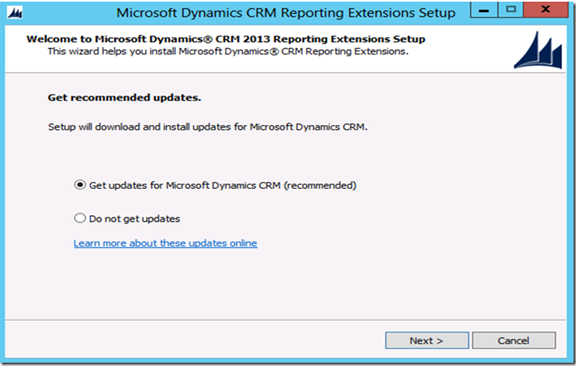
2. License Agreement
Review the information and, if you accept the license agreement, click I accept this license agreement,
and then click I Accept.

3. Install Required Components
If Setup detects that components are missing, the Install Required Components page appears.
a. If you have already installed the required components, this page will not appear.
b. If you have not installed the required components listed, you can install them now. Click Install. When the components are installed, the status column will change from Missing to Installed, and you can click Next to continue.
4. Specify Configuration Database Server
If you are using the default instance of the SQL Server, enter the name of the computer that is running SQL Server and contains the Microsoft Dynamics CRM configuration database that is named MSCRM_CONFIG, and then click Next.
Note: If you are not using the default SQL Server instance, enter <machine-name>\<instance-name>

5. Specify SSRS Instance Name
Select a Microsoft SQL Server Reporting Services instance that will be used for Microsoft Dynamics CRM reporting, and then click Next.

6. Select Microsoft Update Option
Select whether you want to use Microsoft Update for checking for updates for your Microsoft products, and click Next.
We recommend that you use the Microsoft Update to check for updates because this keeps your computer up-to-date and secure.
7. Select Installation Location
Click Browse, and select a path where you want to install CRM Reporting Extensions, and then click Next.
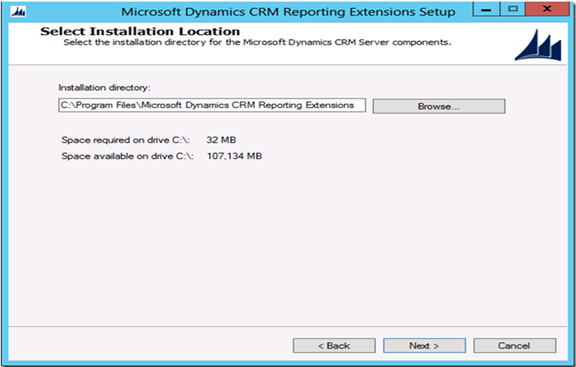
8. System Checks
This page is a summary of the requirements for a successful CRM Reporting Extensions installation. Errors must be corrected before installation can continue. All errors must be resolved. If no errors or only warnings appear, you can continue with the installation. To do this, click Next.
You may get the below error id the Microsoft SQL Server 2012 Reporting Service was installed via default settings- then the service account is set to Report Server
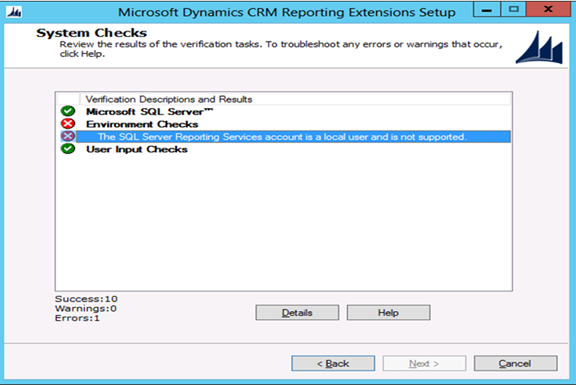
To resolve the issue, open the Reporting services configuration manager and update the Service Account to something else such as "NetworkService"
Once you click on Apply, you will be prompted for the File Location and the password of the Back Encryption Key.
Click Apply and Exit
The table below summarizes the account and provides recommendations for using the service accounts for Reporting Service.
For best results, specify an account that has network connection permissions, with access to network domain controllers and corporate SMTP servers or gateways. The following table summarizes the accounts and provides recommendations for using them.

Read more about Service account for SQL Server 2012 Reporting Services

9. Service Disruption Warning
This page lists all services that will be stopped or restarted during Setup
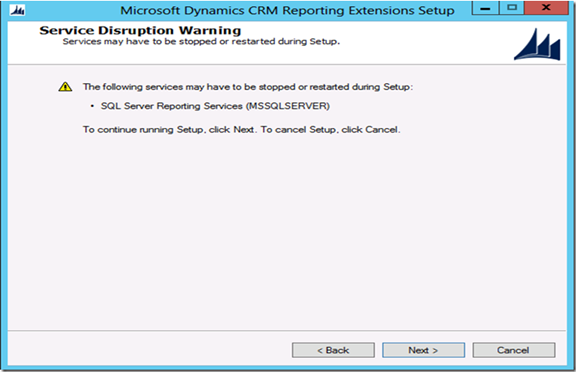
10. Ready to install Microsoft Dynamics CRM Reporting Extensions
Review this page, and then click Back to correct any errors. When you are ready to continue, click Install.

11. Microsoft Dynamics CRM Reporting Extensions Setup Completed
Click Finish

Congratulations you have successfully installed CRM 2013 and ready to go.

You can optionally install the Sample data by navigating to Settings-->Data Management -->Sample Data
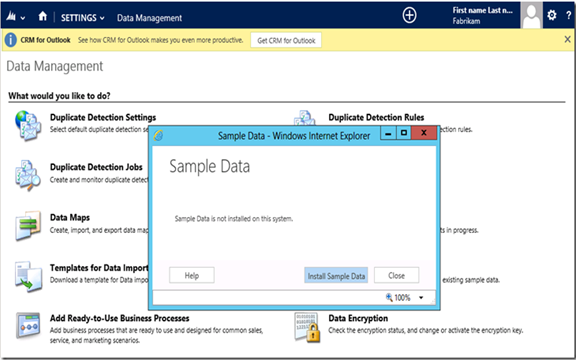
I hope you found this article helpful :)
Comments
Anonymous
November 04, 2013
Awesome , very comprehensive article , thanks for sharing it Niran.Anonymous
November 05, 2013
Yes. Excellent documentationAnonymous
November 05, 2013
Thanks, will come in handy.Anonymous
November 05, 2013
Good one !! Now make this a sizzling Blog!!Anonymous
November 05, 2013
Good one Niran , I followed this blog to achieve the same setup in my environment, very helpful! :)Anonymous
November 11, 2013
Thanks Niran, you post saved me a lot of time.Anonymous
November 12, 2013
in 2 server installation; frontend and backend, which roles&features need to be installed on a frontend and which on backend?Anonymous
November 18, 2013
Thank you. It helped my team in our maiden CRM installation.Anonymous
December 18, 2013
I got following error while opening default site http://CRM2013 ANYONE WHO EXPEREINCED THE SAME....! No microsoft Dynamics CRM user exists with the specified domain namd and user ID A Microsoft Dynamics CRM user record does not exist with the specified domain name and user ID.Anonymous
December 24, 2013
very comprehensive document! Really helpful. Thanks for sharing!Anonymous
January 08, 2014
Thanks All. @erikhoffie The below article talks about the Prerequisites for installing the Backend/Frontend Server roles. Although this is for CRM 2011, it should be applicable for CRM 2013 as well. technet.microsoft.com/.../gg584058.aspxAnonymous
February 26, 2014
Hi Niran Great document, it really helps, I have a question that I think is obvious but. Is there a way to use Windows Azure AD? I want to install dynamics in a virtual machine in Windows Azure. And, it is possible running sql server and crm server in the same vm with a 1.6 ghz procesor and 1.75GB RAM? greetingsAnonymous
March 06, 2014
wonderful document, it really helps. RegardsAnonymous
March 10, 2014
Will CRM 2013 load on Server 2012 R2?Anonymous
March 19, 2014
@Charlie As of now, we don't have any official support for running CRM on Azure VM's. But there are people who have done it on test environments. @Mark CRM 2013 on Windows Server 2012 R2 is not yet supported, but you should hear some updates about it soon.Anonymous
March 26, 2014
Very well documented, really helpful, thank you.Anonymous
April 20, 2014
i had installed CRM2013 and have trouble like this " Unexpected Error , 'An error has occurred. Try this action again. If the problem continues, check the Microsoft Dynamics CRM Community for solutions or contact your organization's Microsoft Dynamics CRM Administrator. Finally, you can contact Microsoft Support.' i had add user in active directory, please help me....Anonymous
April 23, 2014
Hi Niran, At step 5. Specify SSRS Instance Name of Install Microsoft Dynamics CRM 2013 Reporting Extensions, the instance name is not populated automatically nor can I write it in, do you know why? I'm stuck here. Thanks for any help in advance.Anonymous
April 23, 2014
The comment has been removedAnonymous
April 23, 2014
what is IE link for accessing crm web application ?Anonymous
April 24, 2014
Can Exchange and SQL be installed on same machineAnonymous
June 04, 2014
Excellent Article Niran. Thanks a lot.Anonymous
June 04, 2014
excellent article. Thanks a lot Niran.Anonymous
June 04, 2014
Excellent post used it to install. you can improve it by including upgrade from CRM 2011, it will then be a complete CRM 2013 implementation. Thanks.Anonymous
June 09, 2014
Its really VERY VERY VERY Helpful post. Thanks A Lot.................... Improve to 2013 also.Anonymous
June 22, 2014
This article is of great help to new user ! Thanks !Anonymous
June 25, 2014
Thanks a lot for great piece of information. Really helpful.Anonymous
July 13, 2014
Whats next?? Any1 have any guides on what to to post installation??Anonymous
August 05, 2014
Thanks This is very good one Thanks again AdminAnonymous
August 10, 2014
After step 4 I am getting an error - Setup cannot proceed because an error occured while copying installer files to the local system. Any ideas? My user has local admins rights and I am also pressing run as administrator.Anonymous
August 17, 2014
Windows 2008 server enterprise with CRM 2013 and Sql 2012, When the users connecting through remotely Internet expolrer not responding error is coming any idea ? its really urgent any help ?Anonymous
August 17, 2014
Is it possible to migrate from Microsoft Dynamics CRM Workgroup Server 2013 to Microsoft Dynamics CRM Server 2013? We have the Microsoft Dynamics CRM Workgroup Server 2013 and need more users. Is it just a license upgrade or a software upgrade. Also, if its a software upgrade, is migration readily possible from Microsoft Dynamics CRM Workgroup Server 2013 to Microsoft Dynamics CRM Server 2013 ?Anonymous
September 03, 2014
Hello Niran, First of all thank you for blog it helped me a lot. I have same question as shrey. We are planning to upgrade from CRM WG to CRM Dynamics Server. Should we do clean installation are can we just enter the keys for CRM Dynamics Server and the licenses get upgrade. Please let me know. Thank you :)Anonymous
September 09, 2014
Thanks boss its good to start installation without knowing anythingAnonymous
September 29, 2014
What is the login account we should use in SSRS Data Source for FetchXML based reports. Please advise. it is urgent for us.Anonymous
October 09, 2014
Hi at the 19th step i.e., system checks I'm getting this error "You do not have sufficient permission to perform this operation on the specified organization database" (ms SQL server). what to do? help meAnonymous
October 14, 2014
Need to know steps to install CRM Server 2013 on Windows Server 2012 R2 as Windows Server 2008 R2 will be not supported after 7.0.Anonymous
October 15, 2014
Hello, at the beginning of the article you state that server core will not work. However I have configured a lot of our various servers to use Server core. In our CRM environment "complex", I have broken out CRM into servers into 5 Servers in production with various CRM roles. My question to you; Is there any of the roles where it would be OK to convert them into Server Core, Async immediately comes to mind and so does the Database Server. But I would appreciate your input. Additionally it would be nice if MS put an article together describing Multi-Server virtualized environment configuration recommendations, such as memory and vCPU for each Virtual Guest.Anonymous
October 16, 2014
hi i m trying to install the crm but the step 9 is now showing to me, it is directly jumping to step 10 from step 8 what to do?Anonymous
October 22, 2014
Can't install because of language pack. Can't install language pack because CRM isn't installed. How do I get around this catch 22?Anonymous
October 30, 2014
Jason change in control panel the languague of the I dont know how is exactly in english but is some like regional and languague configuration, in my case i used Spanish (colombia) then I change to Spanish (Spain).. check your languague installation packageAnonymous
December 14, 2014
Really explained very nicely. With the help of screen shot it is very easy to understand CRM installation process. Thanks.Anonymous
March 02, 2015
The comment has been removedAnonymous
March 03, 2015
Super tutorial ... well instructed and easy to follow.Anonymous
March 25, 2015
This is great but how do you use a port other than 1433 for sql? When I try , or ; or : separated it fails! ThanksAnonymous
August 23, 2015
helped me a lot!Anonymous
September 20, 2015
Total useless. Active Directory is always difficult to install and setup and nothing about this is covered in this article. Just another useless Microsoft document trash.Anonymous
September 28, 2015
Not a very comprehensive article Author forgot to mention active directory and SQL server installations and requirementAnonymous
October 15, 2015
Thanks Niran, Your blog is very helpful.Anonymous
December 04, 2015
Do you have a link that shows how SQL server report services are supposed to be configured - mind nmumbingly difficult to find the 5 minutes of configuration that is needed here.Anonymous
December 14, 2015
Excellent documentation for Installation and configuration . Thanks a lot.Anonymous
December 22, 2015
I faied in installing crm 2013. I got same results from step 19-21. However, the installation can not end. It stopped. I waited for 10 hours. It has still been showing 'Installing and configuring Microsoft Dynamics CRM Organization'.Anonymous
December 23, 2015
I am able to install all require software into Windows server 2012, but when in MS CRM 2013 almost 70% of installation is completed and then stopped at the following point: Installing and Configuring Microsoft Dynamics organization, Microsoft.Crm.Tools.Admin.ImportDefaultDataAction




